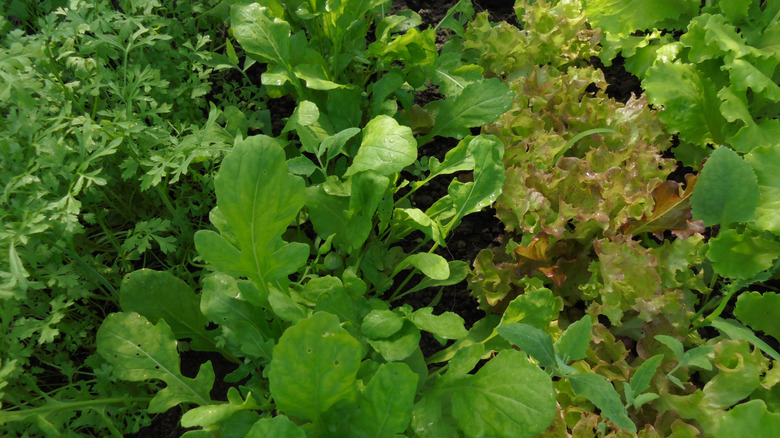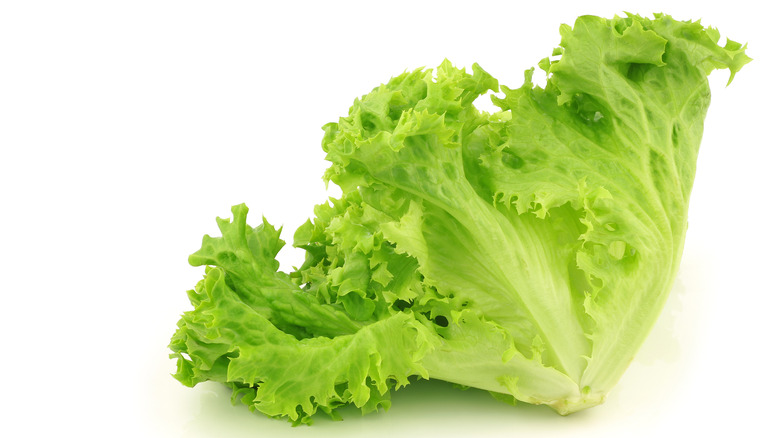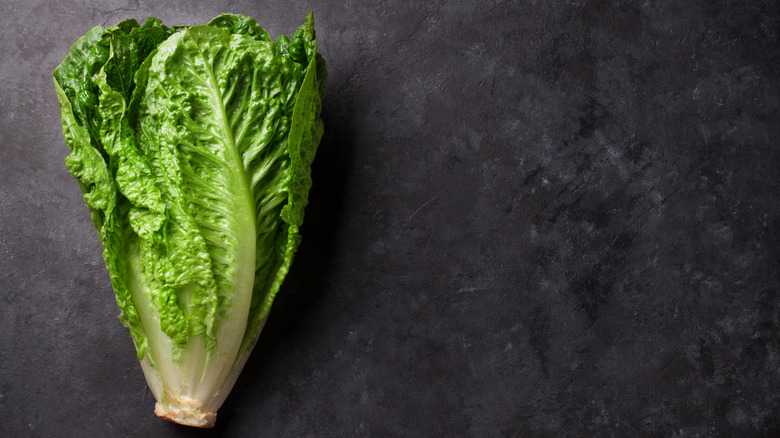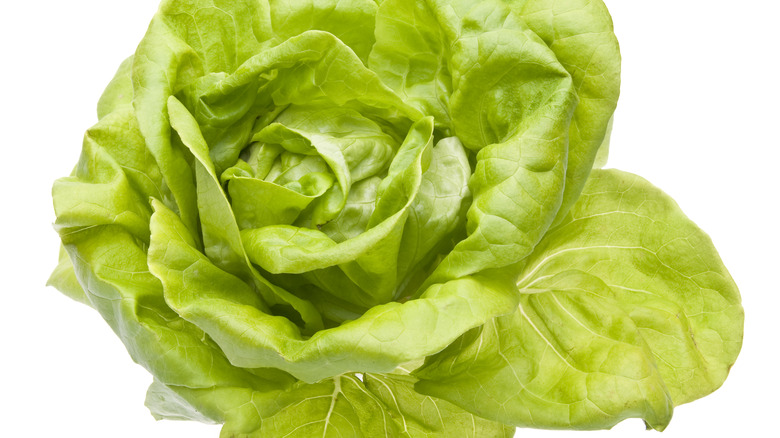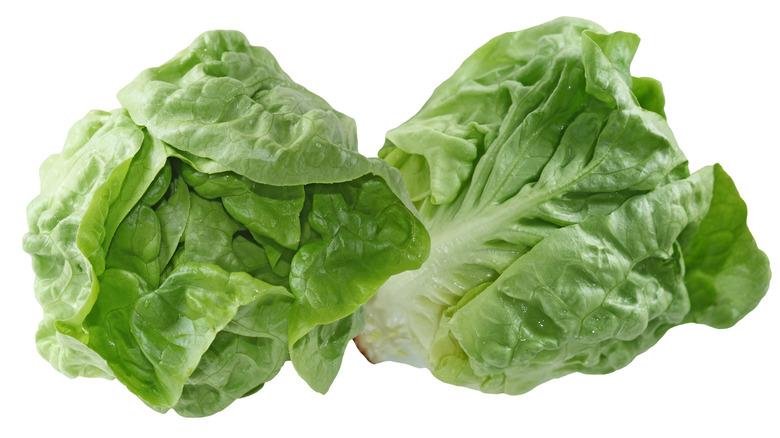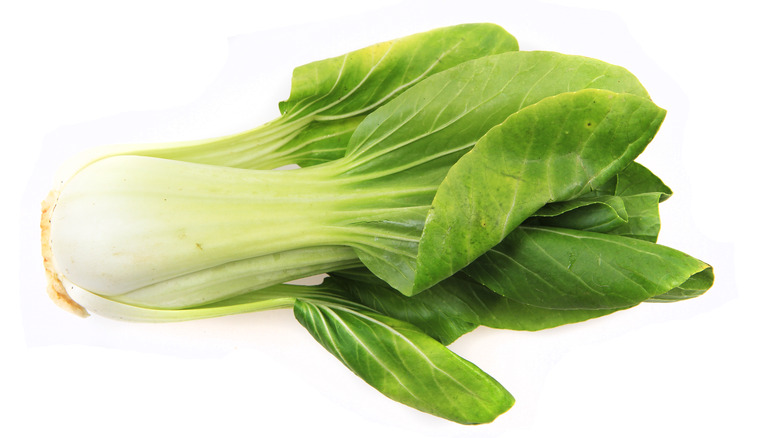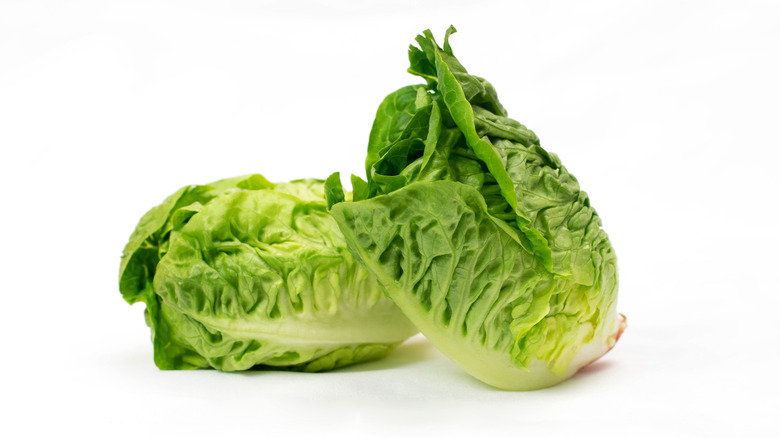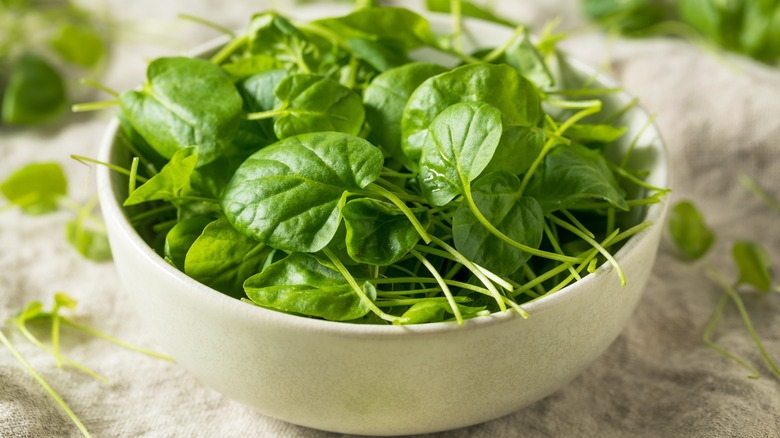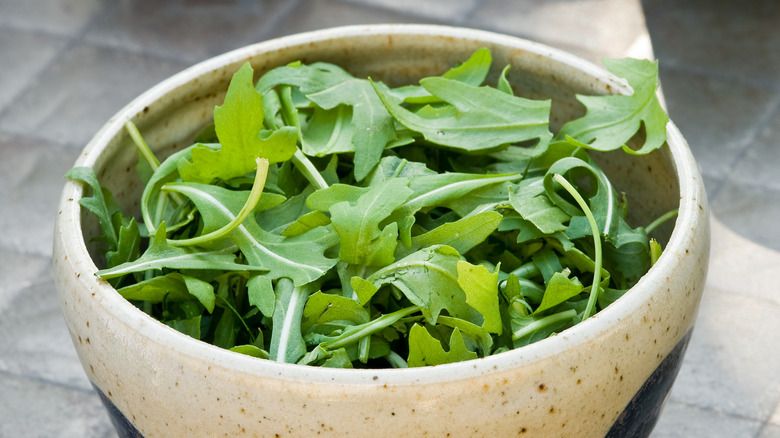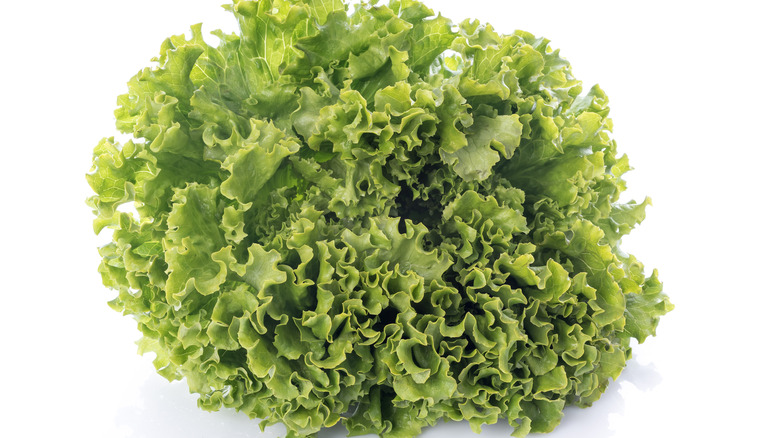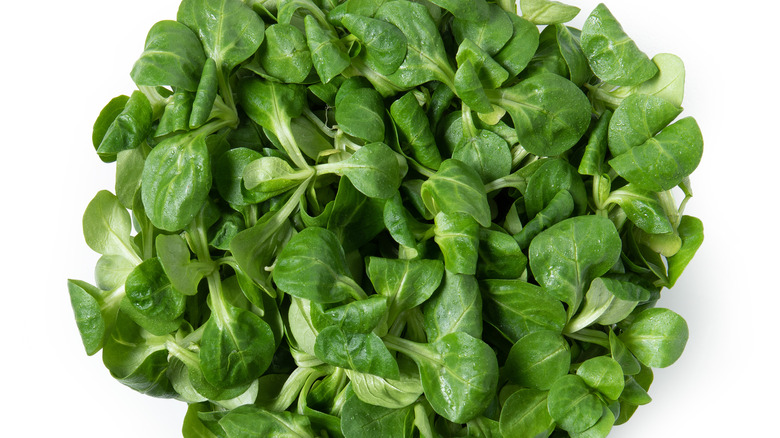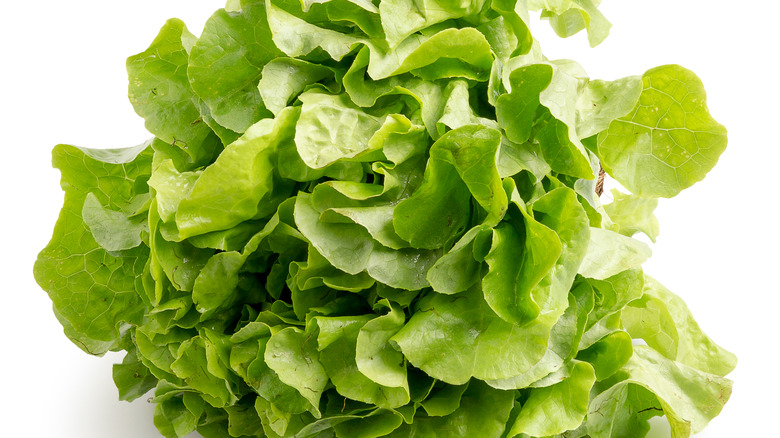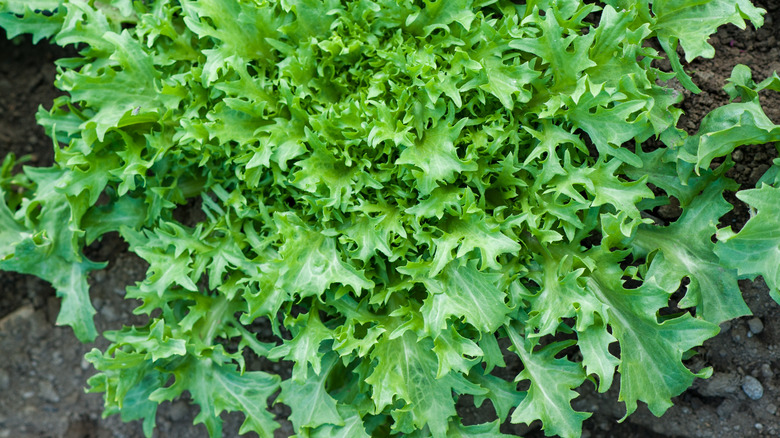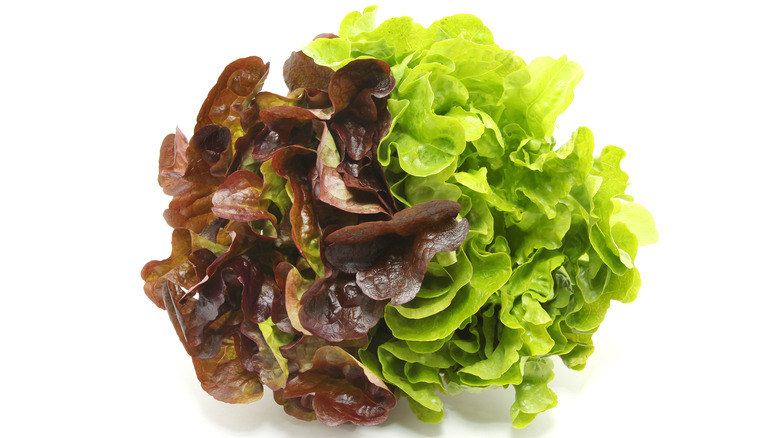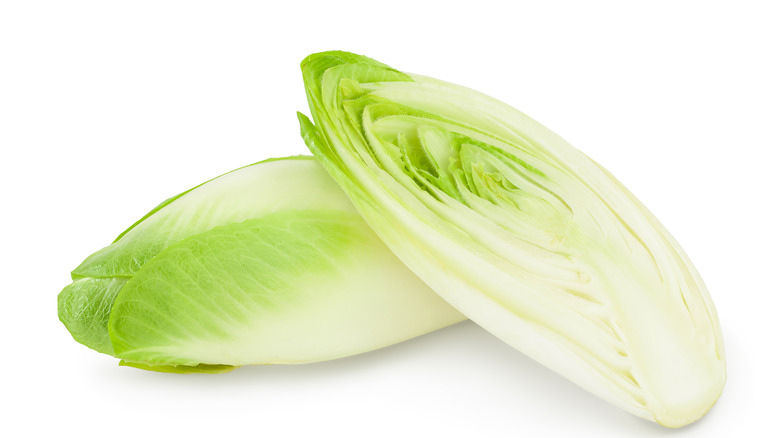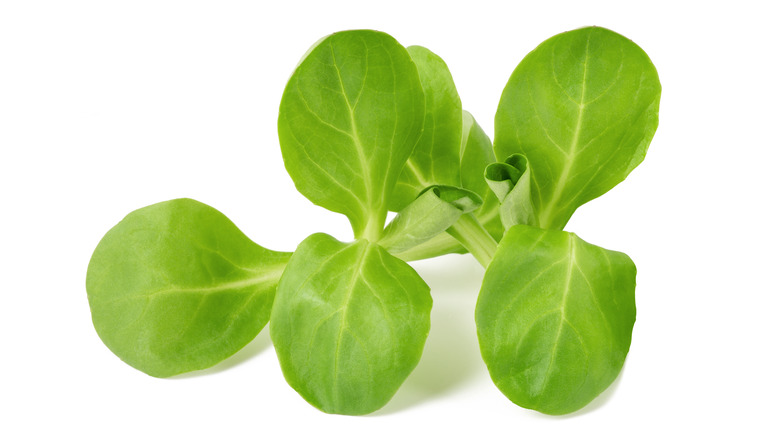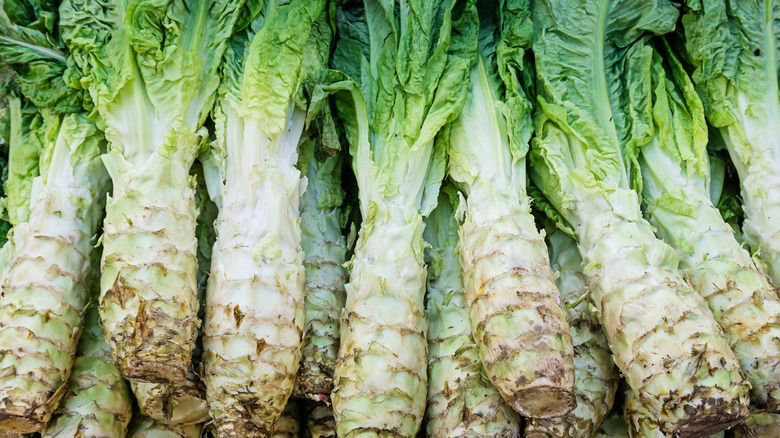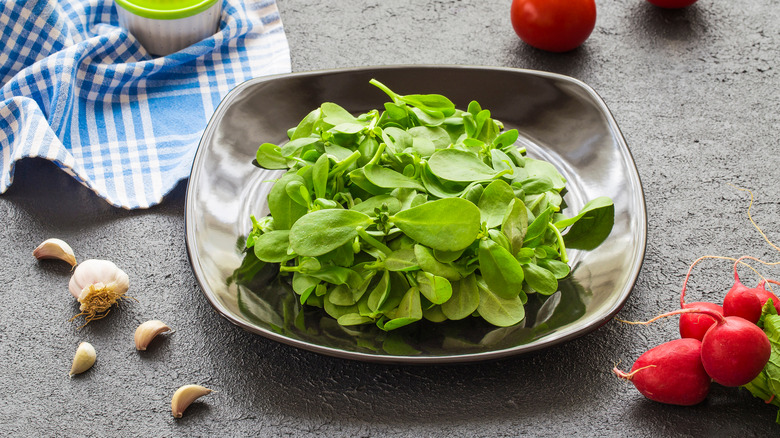18 Types Of Lettuce And What You Can Do With Them
It is always a good idea to incorporate lettuce into your diet. Leafy greens can count as part of the five servings of vegetables you should eat daily, per the American Heart Association. Most types of lettuce are loaded with essential vitamins and minerals, and, according to the U.S. Department of Agriculture, their antioxidant qualities can help fight cancer. In addition, just about every kind of lettuce is low in calories and fat, so you can add it to any meal without any guilt.
So the question here is not whether you should be eating lettuce (of course you should!), but rather, which type is best for you? There are multiple variations on the leafy green that differ in flavor and texture. While salads are an obvious application, certain types are better equipped to handle particular dressings and added ingredients. Some leaves our sturdy enough to be thrown on the grill. Others offer plenty of versatility beyond the salad bowl. If you're looking to broaden your lettuce horizons, we've highlighted 18 different types of leafy greens and all the delicious things you can do with them.
1. Loose-leaf
Loose-leaf lettuce is one of the most popular types of lettuce. It gets it name because the wavy-tipped leaves grow loosely from the stalk. The are several varieties that fall under the loose-leaf umbrella, but at the supermarket you'll most commonly come across the simply named "green" and "red" types. The green varieties are a vibrant green while the red varieties have a purple tinge to the ends of the leaves. (The greener the leaf, the more nutrients it provides, per SF Gate.)
Both types have a mild flavor, making them easy to add to a variety of dishes. Of course, loose-leaf lettuce is ideal for salads, but its large, broad leaves make it ideal for making wraps of all kinds. You can even add it to soups, or sauté it with green peas and garlic for a side dish. When using the lettuce in a cooked meal, add chopped leaves to the dish close to the end of the cooking process in order to avoid any wilting.
2. Iceberg
Also known as crisphead, iceberg lettuce has round, firm heads with tightly-packed leaves. Varieties include Great Lakes, Maverick, Ithaca, Keeper, and Raider. Iceberg is a common addition to sandwiches and burgers because its leaves add the perfect, juicy crunch. If you've avoided eating iceberg lettuce because you thought it lacked nutrients, you might be surprised to know that it does offer vitamin K, potassium, and iron, according to Very Well Fit. It may be the least flavorful type of lettuce, but that just makes it an excellent starter option for those who have a hard time adding leafy greens to their diet.
You can use iceberg lettuce in several recipes such as the classic wedge salad. Shredded iceberg also works well in Tex-Mex tacos for added crispiness. Because the leaves are firm, they make the perfect, low-carb replacement for buns. Simply load them with sliced turkey, cheese, and mayo for a different twist.
3. Romaine
Quite different in shape and taste, romaine lettuce grows oblong leaves with wavy edges. The upper part of the leaves are mild, while the lower sections taste a bit bitter. It boasts some healthy nutrients including decent amounts of magnesium, phosphorous, potassium, folate, and vitamins A, C, and K (via Medical News Today). Because of the risk that romaine lettuce can become contaminated with bacteria, it is always a good idea to wash the heads and leaves thoroughly before eating.
To get the most out of romaine lettuce, you'll want to eat it within a few days of purchasing. The narrow leaves make them ideal cups for small dishes. If folded lengthwise, their shape makes a perfect taco shell. For something different, you can also sauté or even grill romaine lettuce. The charred leaves along with grilled slices of sourdough bread that can be torn to create crispy "croutons" will help take that standard Caesar salad to the next level.
4. Bibb
A type of butterhead lettuce, Bibb has a mild buttery flavor that almost melts in your mouth, according to The Spruce Eats. It also has a hint of sweetness, so you can pair it with blue cheese and pineapple for a tasty combination. You don't want to use a heavy dressing that will weigh down the tender leaves, but there is much more to do with Bibb lettuce than eat it in a salad. If you're trying to cut carbs, the soft leaves make a perfect taco or wrap because they are large and flexible, or you can fill them with shredded chicken or roasted mushrooms.
Bibb lettuce is usually sold with the roots attached. The best way to store it is in the crisper with the roots attached and with a damp cloth over the plastic dome that it comes in. If you remove the roots, it won't stay as fresh.
5. Boston
Boston lettuce is a fluffier and larger type of Butterhead lettuce. It also goes by the name Tom Thumb and May Queen. One cup of Boston lettuce has almost half of the daily requirement of vitamin K and 10% of vitamin A and B9 (via Livestrong). Just be careful because those tender, loose leaves that are prone to bruising. The flavor is mildly sweet, which makes it a nice addition to salads, but it won't give you a nice crunch that many types of lettuce do.
If you use it in a salad, make sure you use a light dressing so the leaves won't wilt. Boston lettuce is ideal to use in sandwiches and burgers because the leaves lie flat. You can also enjoy it as a wrap or cup. For something different, try slicing a head down the middle and tossing the cut side on the grill. Let it char slightly and top with you favorite dressing.
6. Tatsoi
Tatsoi is a small leafy green that looks similar to baby spinach, except the stems and veins on the leaves are white. Before the leaves are removed, it looks like a miniature stalk of bok choy. Like most greens, tatsoi contains several nutrients including iron, phosphorous, potassium, and vitamins A, C, and K. A 100-gram serving also has twice as much calcium as milk, per Heal With Food.
It is actually a part of the cabbage family, but tatsoi, which is highlighted by a sweet, mustardy flavor, is typically used like lettuce in many salads. That being said, you can use this little green in a variety of dishes. Gardening Know How suggests cooking it in stir fry dishes, much like you would bok choy. For something different, try adding the leaves to soups just before serving. Its flavor makes it a nice addition to sautéed spinach or pesto.
7. Little Gem
Little Gem lettuce, also known as sugar cos, looks like a smaller version of romaine lettuce. It is loaded with vitamin A, and it has decent amounts of vitamin C and calcium. A serving also gives you one gram of fiber and protein, per Eat This Much.
The small, narrow leaves are crisp and have a slightly sweet taste. Since it is small, you will most likely see it used in salad mixes. Country Living recommends tossing the small leaves with a creamy dressing and a seed mix for a crunchy side dish. But you don't have to stop there. Its crispness makes it a great addition to any sandwich, and you even make mini wraps with it. Because the leaves are firm, you might enjoy using them as a scoop for your favorite dip. For something different, try cutting the heads in half, grilling them lightly, and sprinkle with your favorite toppings.
8. Watercress
Small and slightly bitter, watercress is actually from the mustard family, and its petite leaves are packed with nutrition. One serving contains more iron than the same amount of spinach and more than the recommended daily allowance for vitamin K. In addition, it contains lutein, vitamin A and C, as well as manganese, per Healthfully.
Of course, watercress is a perfect addition to salads, but you can add a few leaves to bump up the nutritional value of a smoothie or glass of juice. It is a popular addition to many sandwiches, too. The leaves offer a nice garnish for many dishes. Try it on pizza — just sprinkle the watercress over your pie after you remove it from the oven. To enjoy it in an omelet, wait until the eggs are almost done and add the leaves just before you fold it over. You can even make watercress soup.
9. Arugula
Arugula is a small leafy green that is technically a cruciferous vegetable. You'll usually find it sold in bunches at the store. Generally, raw leaves and stems are used in dishes, but you can increase its flavor by steaming or sautéing it. Either way you eat it, you'll get a good dose of vitamin K and glucosinolates, which are cancer-fighting compounds.
The leaves, which have a peppery, mustard-like taste, are ideal for salads, but you can also add them to noodle and pizza dishes to add a bold flavor, per Real Simple. You can incorporate some leaves into pasta dishes for a kick (crispy sheet pan gnocchi, perhaps?) or sprinkle it on top of pizza to add a bold flavor. Another option is put it to couscous and quinoa dishes as well as quesadillas. Try it on a grilled cheese to add a burst of flavor (via Cooking Light).
10. Batavia
Batavia is a type of crisp head lettuce that is like a cross between loose-leaf and iceberg lettuce. Like loose-leaf lettuce, you can find varieties with red and green leaves with wavy edges. Batavia lettuce is less dense than iceberg lettuce, but not quite as loose as loose-leaf varieties, per Colorado State University. It has a touch of sweetness, and the large leaves make it an easy choice for just about any kind of wrap, especially ones with cream cheese and smoked chicken.
Because it has a nice flavor, you can enjoy it on burgers, and it pairs well with cheese, sausage, or tuna salad, according to Love My Salad. Shred it and enjoy the sweet taste in tostadas or spring rolls. If you have some Batavia lettuce that is almost wilted, sauté it in a skillet with olives and bacon bits. Just make sure not to cook it for too long.
11. Lamb's lettuce
Lamb's lettuce grows in small rosettes, and it has small, bright green leaves. According to the Louis Bonduelle Foundation, there are two main varieties of it: coquille and blonde. The coquille variety has round leaves, while the leaves on the blonde variety have lighter green leaves that are longer and more oval-shaped. Lamb's lettuce has a slight nutty flavor. This leafy green contains beta carotene, iron, phosphorus, magnesium, and calcium.
The leaves are delicate, so when you wash it, rinse them under cold water to prevent them from wilting. If you decide to eat it in a salad, add the dressing at the last minute, which also prevents any wilting. It pairs well with carrots, beets, tomatoes, dried fruit, seafood, fish, and most cheeses. Lambs lettuce may wilt when cooked, but it can be heated for a few minutes if you decide to enjoy it with soups and gravies.
12. Oak leaf
Oak leaf lettuce gets its name from its leaves, which are similar to the shape of oak leaves (via Gardeners' Magazine). The leaves are wavy like loose-leaf lettuce varieties, but they are smaller. Red varieties have a deep purple color along the outer edges, but all varieties are known for their mild, slightly nutty flavor. Rich in flavonoids and vitamin A, oak leaf lettuce is a good choice if you're looking to up your antioxidant game (via Heal with Food).
As far as eating it, if you use it in a salad, use an oil-based dressing because that will make the carotenoids more bioavailable to your body. Enjoy it as a wrap or use it in spring rolls. According to Specialty Produce, the flavor of the oak leaf lettuce leaves pair well with pine nuts, almonds, apples, pears, and sharp cheeses like Roquefort and gorgonzola. While it may taste great alongside apples and pears, store your lettuce away from the fruits, which release a natural gas that cause your leaves to wilt.
13. Frisée
Frisée, also known as curly endive, is a member of the chicory family. The leaves are thin and curly, with most of them are a shade of pale green with slight yellow colorations. The stems are crunchy, which means they add texture to whatever dish you add them to. One serving, or around 30 grams, of frisée contains all of the vitamin K you need for one day, according to Half Your Plate.
Frisée has a distinct, bitter taste. Because it is rather small, you will most likely see it chopped and used primarily in salads. It pairs well with creamy dressings, herb-flavored croutons, and tart fruit. Most recipes use frisée raw, but you can eat it slightly warmed. Try Martha Stewart's recipe that blends noodles, eggs, bacon, and parmesan cheese for a warm, satisfying meal. Another use for this peppery leafy green is sprinkled over baked chicken. It makes a nice garnish for cheese platters, too.
14. Mignonette
Mignonette lettuce is a type of butterhead lettuce that has a mild, tart flavor. The heads are round, and the leaves are large with slight waves. One variety has a bronze tint on the edges, which is aptly named Bronze Mignonette. The leaves are crisp, which makes them ideal for a variety of dishes. If you use this in salads, mix it with other ingredients that have strong flavors.
Like many other types of lettuce, Mignonette lettuce makes a perfect replacement for bread or tortillas. Simply fill it with a variety of meat and cheeses for a low-carb, low-calorie dish. For example, you can fill the leaves with tomatoes, mozzarella cheese, and cooked pepperoni or sausage for a low-carb Italian sandwich. You can even scoop egg salad or chili onto the leaves for something different. Or you can fill wraps with vegetables such as broccoli, carrots, and snow peas.
15. Belgian Endive
Not technically a lettuce, Belgian endive is an excellent choice if you want to add a slightly bitter flavor to any salad. This oblong stalk is actually part of the chicory family, and you can find varieties with green or purple edges on the leaves. Belgian endive is crunchy, but bitter. Like most lettuce, it boasts several healthy vitamins and minerals including vitamin A, vitamin K, and folate, per Very Well Fit.
The firm leaves of Belgian endive work well as a cup for serving small, bite-size dishes, such as hors d'oeuvres, and as a healthy replacement for chips or crackers. So the next time you're craving hummus, grab some Belgian endive to go along with it. You can also bake the leaves for a Belgian endive and blue cheese gratin, add them to a stir fry, or coat them with olive oil and grill them. Endives can also replace cabbage in soup recipes.
16. Mache
Mache lettuce is a small green, much like watercress. You may also know it also known as corn salad. This green has small rounded leaves that look like watercress and have a slightly nutty taste that pairs well with mustard greens. Like most other greens, mache offers up some nutritional value that includes a hefty serving of vitamins A and C. A serving also has more iron than spinach, according to One Green Planet.
The small leaves are an excellent choice for greens on sandwiches and subs. You can steam mache with other vegetables, or you can try sautéing it with vegetables in omelets. It also works well in soups or rice dishes. If you decide to cook with it, add the leaves at the end of the cooking process to avoid wilting (via Gardening Know How). For the best flavor, eat mache within a week of the purchase date.
17. Celtuce
Celtuce, sometimes called asparagus or celery lettuce, has a long, slender stem with large floppy leaves. The lettuce cousin has long been popular a popular ingredient in Chinese cuisine. The best part about celtuce is the fact that you can eat the leaves and stems. And, you can do just about anything you want with it, according to Women's Day. With a slightly nutty flavor, you can serve it as a main dish or a side dish, and you can eat it cooked or raw. When cooked it retains its crunch.
The best way to eat the stem is to use a peeler or spiralizer to make sections that are about the size of noodles, and you can use them the same way you would use noodles in any dish. Nutritionally, celtuce is low in calories and fat and has several nutrients, including B and C vitamins, phosphorus, potassium, magnesium, and iron.
18. Purslane
Purslane sometimes goes by the name pigweed or little hogweed, according to Grow a Good Life, but you shouldn't let that stop you from experimenting with it. It has small, juicy leaves that have a salty sour taste. You can find it growing wild, and it can survive some of the most harsh environments, so if you like growing your own greens, purslane could be a nutritious addition to your garden. It contains vitamins A and C, potassium, calcium, magnesium, and iron. It is unique in that it is contain omega-3 fatty acids. This little green is also a good source of beta-carotene, an antioxidant that fights damage done by free radicals, per Web MD.
You can eat the leaves, flowers, and stems of purslane. Since it is small, you may want to add it to a variety of dishes including soups and salads. It is also easy to toss a few sprigs in with your grilled vegetables right before they are cooked.
